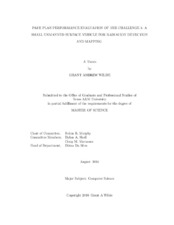| dc.description.abstract | This thesis will compare the performance of the Challenge 1 unmanned surface vehicle when autonomously conducting a radiological survey of a bounded, obstacle free, convex polygon via a traditional raster scan versus a novel spiral-like path plan. Currently, unmanned ground vehicles (UGV), unmanned aerial vehicles (UAV), and unmanned surface vehicles (USV) use a simple raster scan to insure complete coverage of a predefined, obstacle free area. Raster scans require a 180 degree change in heading which is easy for tracked UGVs and vertical take-o_ UAVs to accomplish, but more difficult for marine vehicles and fixed winged UAVs. A spiral-like path plan will not completely eliminate turns close to 180 degrees, but presents the possibility of removing the number of sharp turns at the expense of adding more slight turns. The author of this thesis originally hypothesized that this spiral-like path plan would result in shorter autonomous surveys by the Challenge 1 USV, as well as a higher percentage of coverage. Shorter surveys will allow operators such as the mission specialist overseeing a disaster in which radiological material may be present or treaty verification inspectors searching a facility to conduct more surveys in a limited time, which therefore increases the total area searched over this time period as well as provides data to the mission specialist faster. A higher percentage of coverage attained by the spiral-like path plan would guarantee a more complete representation of the area surveyed.
To test this hypothesis the author used the 1.15 acre pond at John Crompton Park in College Station, Texas, to generate twenty-five unique convex polygons via teleoperation of the Challenge 1, ranging in size from 450 square meters to 1027 square meters, to which a raster path plan and spiral-like path plan were each used by the Challenge 1 to survey the area, resulting in fifty total runs. Following the data collection, the associated log from each run was used to calculate total survey time, total survey distance, root mean square of cross-track error, Hausdorff Distance (max RMS error), percent coverage, and percent of survey locations inside the bounded convex polygon. The average survey time for a spiral like path plan versus a raster scan was 13.68 seconds shorter (p < :59). The average total distance for a raster path versus a spiral like path was 15.53 meters less (p < :061). The average RMS of cross-track error for a spiral like path plan versus a spiral path plan was 0.31 meters less (p < :123). The average Hausdorff Distance for a spiral like path plan versus a raster scan was 1.53 meters less (p < 0:0005). The average of percent coverage for a raster scan versus a spiral like path was 4:22% higher (p < 0:027). The average of percentage of locations in the bounding area for a raster path versus a spiral like path was 16:88% higher (p < 0:00023). This shows that for α = :05, there is no statistical difference between either of the two path plans for survey time, survey distance, or RMS of cross-track error. However, there is a statistical difference between the two path plans for Hausdorff Distance, percent coverage and percentage of locations inside the bounding area. Due to the spiral path plan's inability to maintain locations inside the bounding area, a raster scan is the best path plan to use when surveying a bounded convex polygon with the Challenge 1 since it results in the highest percentage of coverage with no statistical difference in survey time, survey distance, or RMS of cross-track error. This result is only guaranteed for the Challenge 1 and its associated controller, with potentially different outcomes if tested on other surfaces vehicles, especially those with underwater propellers, rudders, or jet pump (no propeller or rudder) propulsion systems. | en |


